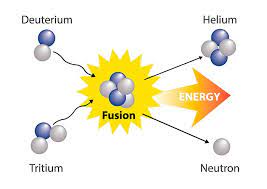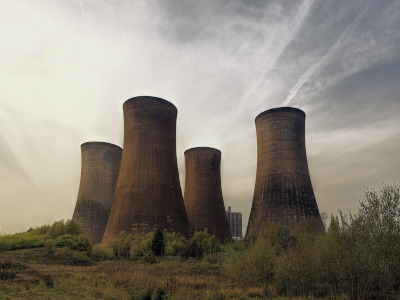Nuclear fission, yes or no? This debate is going on since decades. In this article, I want to bring this debate into the future.

But first of all: What is Nuclear fission?
In the reaction of Nuclear fission, a neutron gets shot into a bigger atom, forcing it to excite and split into two smaller atoms. That is the start of a chain reaction, in which other neutrons get released and split other atoms. The goal of this process is to gain large amounts of energy in form of heat. These heat heats water into steam, that then will spin a turbine. Through the rotation, electricity is produced by a generator. 10% of the electricity worldwide is produced by nuclear power plants.
Since we know what Nuclear fission is, we should point out the pros and cons.
Lets start with the positive aspects of producing energy with Nuclear material like uranium and plutonium:
Unlike fossil fuel combustion, nuclear power generation does not emit carbon dioxide, what is the main cause of climate change, or any other pollution. When I say it doesn’t pollute, I have to be more precise, because the process of mining, refining, and preparing uranium uses energy, and nuclear waste poses a completely separate environmental problem.
The second advantage is the huge amount of electricity, that one nuclear power plant can produce. It produces 1 Gigawatt of electricity. That means, that 100 million LED bulbs could run 24/7 or 690,000 homes can be provided by only one nuclear power plant.
Hand in hand with the last point, goes the physical space that is used for a nuclear power plant. Since one nuclear power plant produces so much electricity, you only need one to produce 1000 Megawatt electricity. That takes up about one square mile of space. A Wind farm needs for the same amount of energy 360 times as much space. This are 3,125 Million Solar panels or 431 wind turbines.
Last but not least, it is the reliable and constant production, that makes the nuclear power plant so attractive. It is not dependent on environmental influences such as wind or sun. For that reason, the electricity, that is produced by a nuclear power plant is used 24/7. At night, other power plants like storage hydro-power plants, use the electricity that is not needed, to restore the water in the Reservoir.
Let’s get to the disadvantages:
The first disadvantage I want to tell you about, is the high cost of a new nuclear power plant. Even if it might be cheap to run, it is very expensive to build one. The building needs complicated protection systems, that drive up the costs. The prize of building one is around 20 billion US-Dollars.
But for me, that is the smallest disadvantage, since probably now one of us wants to build or buy a nuclear power plant. A disadvantage that concerns all of us is the nuclear waste. Since the waste of the fuel is radioactive, it is much more than complicated to dispose. Our governments spend tons of money and time to get rid of 34,000m3 of nuclear waste each year.
Third we have the fuel itself. Uranium ore is found in the earth crust and is not renewable. It only exists in an certain amount. Other than wind or sun, it will be used up at some point. So electricity obtained from nuclear fission, is limited to the amount of Uranium existing on earth.
The last disadvantage that I am going to tell you about, is for most people the most important argument, why nuclear power plants should not be used at all.
If there is a failure of a nuclear power plant, it has catastrophic consequences. Sadly, there have already been two such disasters:
March 11 of 2011 in Fukushima: An earthquake and a tsunami were detected, which was followed by an automatic shut down of the normal power-generating fission reactions of the nuclear power plant. Since the electricity of the nuclear power plant is one of the main sources for electricity, the reactors electricity supply failed, and their emergency diesel generators automatically started. However, the flooding, caused by the tsunami, led to the failure of the emergency generators and loss of power to the circulating pumps. The resultant loss of reactor core cooling led to three nuclear meltdowns, three hydrogen explosions, and the release of radioactive contamination.
Not only 110,000 people had to be evacuated, but also large amount of water, contaminated with radioactive isotopes were released into the pacific ocean, which let to contaminated animals and plants.
26 April 1986 in Chernobyl: The disaster occurred during the safety test of the steam turbine. Due to an human mistake, the power output dropped to near-zero. Due to a design flaw, other tests resulted an increases in reactivity within the reactor, followed by the rupture of fuel channels, leading to a rapid decrease in pressure which caused the coolant to flash to steam. The cooling system heated up and let to a reactor meltdown.
Enough said about the nuclear fission. Lets get to a way of power generation, that will possibly eclipse all other possibilities, as soon as the research is far enough. Nuclear fusion.
Nuclear fusion is a reaction in which two or more atomic nuclei combine to form one or more different atomic nuclei. The difference in mass between the reactants and the products manifests itself in the release of energy.

The positive thing is, that the fusion of atoms produces 10 million times more energy, than the burning of fossil fuels. Consequently, the amount of fuel needed in a nuclear plant is much smaller compared with those of other types of power-generating facilities.
Even if nuclear fusion doesn’t produce that much pollution, it still produces nuclear waste. The reaction of the nuclear fusion produces nuclear waste that does not have alpha particles, beta particles, and gamma rays as radiation. Even if all protective layers would fail, the neutron radiation will stop as soon as fusion reaction stops. The nuclear waste, produced by nuclear fusion, has to be safely stored for 100 years, until it can be reused.
Sounds everything pretty good so far, right?
And there are more good news about the research of the fusion:
In December of 2022 the news all over the world reported about the breakthrough in nuclear fusion energy. US scientists achieved something, that brought the research to the next step. For the first time, they had an higher output of energy than input. But still, it will take many more years to use nuclear fusion in our household.
I hope I was able to give you an overview about nuclear fission and nuclear fusion. Since it is such a big topic, I was not able to present all arguments for or against those processes, but I think you got a pretty good knowledge of nuclear fission and fusion. If you want to take part of the debate with the topic ‘nuclear fission, yes or no?’ you should hurry, because I think it will be over as soon as nuclear fusion is more researched.
Sources:
https://www.eia.gov/energyexplained/nuclear/data-and-statistics.php (November 18, 2022)
https://www.energysage.com/about-clean-energy/nuclear-energy/pros-and-cons-nuclear-energy/ (11/10/2021)
https://www.power-technology.com/features/nuclear-power-pros-cons/ (May 28, 2019, by Jack Unwin)
https://thebulletin.org/2019/06/why-nuclear-power-plants-cost-so-much-and-what-can-be-done-about-it/ (by Daria Iurshina, Nikita Karpov, Marie Kirkegaard, Evgeny Semenov, June 20, 2019)
https://connectusfund.org/nuclear-fusion-pros-and-cons-list ( by Editor in Chief)
https://www.bbc.com/news/science-environment-63950962 (13 December 2022 by Esme Stallard)
https://en.wikipedia.org/wiki/Fukushima_nuclear_disaster (19 May 2023)
https://en.wikipedia.org/wiki/Chernobyl_disaster (9 May 2023)

